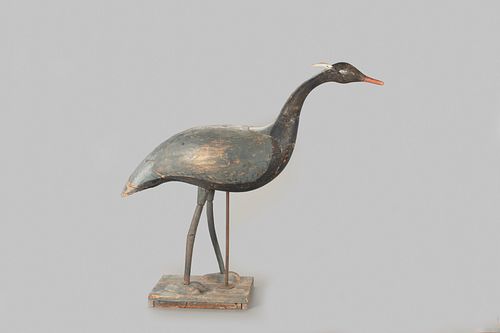Reaching Great Blue Heron from India
Lot 466
About Seller
Copley Fine Art Auctions
20 Winter Street
Pembroke, MA 02359
United States
Founded in 2005, Copley Fine Art Auctions is a boutique auction house specializing in antique decoys and American, sporting, and wildlife paintings. Over the course of the last two decades, the firm has set auction records for not only individual decoy makers, but also entire carving regions. Copley...Read more
Categories
Estimate:
$8,000 - $12,000
Absentee vs Live bid
Two ways to bid:
- Leave a max absentee bid and the platform will bid on your behalf up to your maximum bid during the live auction.
- Bid live during the auction and your bids will be submitted real-time to the auctioneer.
Bid Increments
| Price | Bid Increment |
|---|---|
| $0 | $50 |
| $1,000 | $100 |
| $2,500 | $250 |
| $5,000 | $500 |
| $10,000 | $1,000 |
| $25,000 | $2,500 |
| $50,000 | $5,000 |
About Auction
By Copley Fine Art Auctions
Jul 15, 2022
Set Reminder
2022-07-15 10:00:00
2022-07-15 10:00:00
America/New_York
Bidsquare
Bidsquare : The Sporting Sale 2022, Day 2
https://www.bidsquare.com/auctions/copley/the-sporting-sale-2022-day-2-9461
Lots 333-676 Copley Fine Art Auctions cinnie@copleyart.com
Lots 333-676 Copley Fine Art Auctions cinnie@copleyart.com
- Lot Description
Reaching Great Blue Heron
India, c. 1900
32 1/2 in. tall, 41 in. long
"When well conceived and endowed with the awkward grace of the great bird itself, a heron decoy can take command of almost any collection. Their variety runs the entire gamut from the most primitive forms to beautifully carved and painted examples.” — William J. Mackey Jr., "American Bird Decoys"
True working heron decoys are difficult to obtain, with surviving decoys by known makers nearly non-existent. Heron carvings were often used as confidence decoys for other species and lore has it that some of the old baymen collected them as tablefare. These waders were additionally hunted for their plumage until they received full legal protection under the Migratory Bird Treaty Act of 1918.
Herons' use as confidence decoys was not adopted in most areas and most makers never added one to their rigs. This grand carving measures over forty inches from tip to tail. Similar to the geese of Charles Safford and John Tax, the large hollow body was made with multi-piece construction. The head is in a reaching position and cocked to the right.
The underside is fitted with two legs and a metal support rod. One known related example was sold in 2021 as part of the Linda E. Johnson Collection.
Mix of old paint with heavy wear, working repairs, loss to tail, and contemporary restoration to body, bill, and legs.
Provenance: Private Collection, New England
Literature: Ludovic du Faux, "Ces Oiseaux Qui Ne Volent Jamais," chapter D. 29 L'Inde, see related examples.
Copley Fine Art Auctions, "The Johnson Collection of American Bird Decoys," Hingham, MA, July 9-10, 2021, inside back cover and lot 26, closely related example illustrated. William J. Mackey Jr., "American Bird Decoys," New York, NY, 1965, chapter IV, herons discussed and illustrated.Please email condition report requests to colin@copleyart.com. Any condition statement given is a courtesy to customers, Copley will not be held responsible for any errors or omissions. The absence of a condition statement does not imply that the lot is in perfect condition.Condition
- Shipping Info
-
Shipping info
Copley does not offer in-house packing or shipping. For clients who require shipping, please complete the Shipping Release Form and return it with your payment. The form includes a list of shippers we frequently work with.
-
- Buyer's Premium



 EUR
EUR CAD
CAD AUD
AUD GBP
GBP MXN
MXN HKD
HKD CNY
CNY MYR
MYR SEK
SEK SGD
SGD CHF
CHF THB
THB














